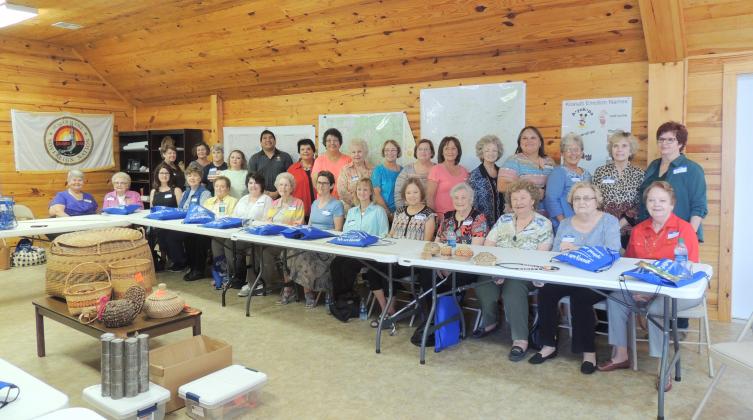
Acadia Chapter Daughters of the American Revolution were guests of the Sovereign Nation of the Coushatta Tribe of Louisiana in Elton. Regent, Charlene Lacombe and Jonas John, Director of the Heritage Department of the Coushatta Tribe, planned an educational program for Oct. 12. Plans were discussed to present the history of the tribe by American History Chairman Alma Reed and Women’s Issues Chairman, Camille Reed.
The Tennessee River County, now known as Alabama, was the home of members of the Creek Confederacy in 1540. Their journey lasted 100 years as they became know as the lost tribe. At this time they were known as the Koastis Tribe and today known as the Coushatta Tribe. The last conflict led to the Creek War of 1813-1814. The violent conflict claimed 3,000 warriors lives and the loss 322 million acres of Indian land. The small bands of Indians separated causing less strength in number.
As the Coushatta’s continued their movement to find land of peace, they traveled through the states of Georgia, Alabama, Mississippi and eventually ending their long journey in Kinder in 1861. During their long journey, the people followed the rivers and streams providing them with food, water and shelter. The 80-100 members of the original group was lead by Chief Stilapihkachatta or Red Shoes in 1797. They were later joined by several hundred members and settling in the lower area of the Red River in Louisiana.
At the beginning of the Civil War in 1861, approximately 250 tribe members had settled near Kinder on the Calcasieu River making this movement their final trip . The tribe began their community of nearly 1,000 acres of farmland, forest and lush green swamps north of Elton for their final home near Bayou Blue. In the 1930’s,the Bureau of Indian Affaires assumed the aiding in the education of the Coushatta children. The elementary school which included grades 1-5 was established as well as medicinal aid for the tribe. In 1953 the services were discontinued.
In 1965 the redevelopment, began as the Coushatta members began discussing to regain their recognition by the Federal government. Recognition by the Louisiana State Legislature came in 1972. The Coushatta Indian Tribe was finally recognized as a sovereign nation on June 27, 1973 by the Secretary of the Interior. The present home was confirmed by a federal proclamation in 1975, when 15 acres was designated as the Coushatta Indian Reservation land by the Federal proclamation. Nearly 140 acres was designated as the Coushatta Reservation land five years later.
In 1991 the Tribe was recognized as a Sovereign Nation by the State of Louisiana. Today the tribe is approximately 960 members. Last names for the families was assigned to them by the federal government when they became citizens of the United States.
As a requirement by the federal government the Tribe had to produce their emblem to be used as their official recognition. The symbol was chosen to represent the Coushatta Tribe was a Garfish, which they used as food, medicine and also for making jewelry. The colors represented the traditional clothing worn by the Indians, black represented night, white for daylight, yellow for the sun, orange for discipline and red for the life-giving blood.
In 2017, seven Clans represent the Coushatta tribe; the Deer, Beaver, Panther, Bobcat, Daddy Long Legs, Bear and Turkey. Originally they were represented by twelve Clans. The Clans was to honor the women, also referred to as the Clan Systems.The Clans was used as political positions and ceremonial rights, using the mothers side of the family. Clans were passed to the female children by their mothers.
To preserve their heritage, the tribal language, Koastis, is still spoken by 25% of the tribe of 960, they developed their own dictionary. Through educational development, The Heritage Department and their Language Center and The Immersion Program continued the traditions of their ancestors, tribal dancing, tribal food, hunting skills, games, basket weaving using long leaf pines and cane for weaving of their baskets are keeping their way of life and traditions alive. Classes are offered to members to preserve their culture. Various baskets were on display and the history of each basket was discussed by John. The cutting of the cane for the baskets was demonstrated by Kassie Dawsey. John also explained the games played by the Coushatta members, he showed the sticks used in the games. He makes the sticks out of white oak which is sold in their gift shop, along with baskets, jewelry, jelly and art.
At the close of the program, Anna Thompson, gave the blessing for the meal in their native language. Anna and her husband, Claymon, tribal members, treated their guest to Indian Fried Bread. This tradition was learned from past generations of the women of the Clans.
Gifts were presented to each member of the Acadia Chapter DAR and their guests by the Coushatta Tribe. The Acadia Chapter also presented gifts to the tribal members presenting the program. The group gathered at Neptune’s in Elton for lunch, the Acadia Chapter DAR invited the members of the Coushatta Tribe as their guest for lunch.
